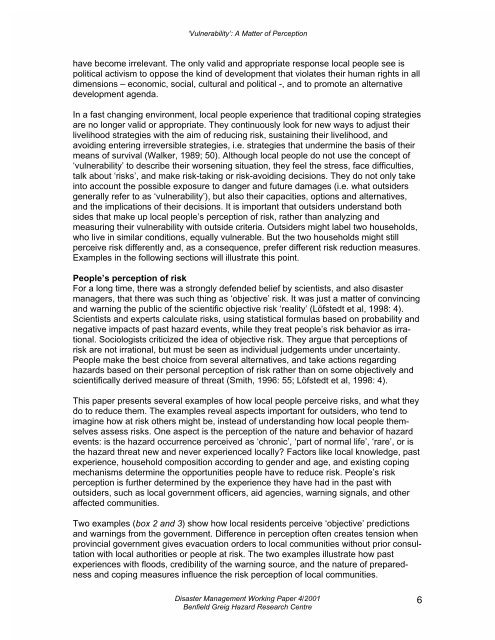'Vulnerability': A Matter of Perception - nirapad
'Vulnerability': A Matter of Perception - nirapad
'Vulnerability': A Matter of Perception - nirapad
You also want an ePaper? Increase the reach of your titles
YUMPU automatically turns print PDFs into web optimized ePapers that Google loves.
‘Vulnerability’: A <strong>Matter</strong> <strong>of</strong> <strong>Perception</strong>have become irrelevant. The only valid and appropriate response local people see ispolitical activism to oppose the kind <strong>of</strong> development that violates their human rights in alldimensions – economic, social, cultural and political -, and to promote an alternativedevelopment agenda.In a fast changing environment, local people experience that traditional coping strategiesare no longer valid or appropriate. They continuously look for new ways to adjust theirlivelihood strategies with the aim <strong>of</strong> reducing risk, sustaining their livelihood, andavoiding entering irreversible strategies, i.e. strategies that undermine the basis <strong>of</strong> theirmeans <strong>of</strong> survival (Walker, 1989; 50). Although local people do not use the concept <strong>of</strong>‘vulnerability’ to describe their worsening situation, they feel the stress, face difficulties,talk about ‘risks’, and make risk-taking or risk-avoiding decisions. They do not only takeinto account the possible exposure to danger and future damages (i.e. what outsidersgenerally refer to as ‘vulnerability’), but also their capacities, options and alternatives,and the implications <strong>of</strong> their decisions. It is important that outsiders understand bothsides that make up local people’s perception <strong>of</strong> risk, rather than analyzing andmeasuring their vulnerability with outside criteria. Outsiders might label two households,who live in similar conditions, equally vulnerable. But the two households might stillperceive risk differently and, as a consequence, prefer different risk reduction measures.Examples in the following sections will illustrate this point.People’s perception <strong>of</strong> riskFor a long time, there was a strongly defended belief by scientists, and also disastermanagers, that there was such thing as ‘objective’ risk. It was just a matter <strong>of</strong> convincingand warning the public <strong>of</strong> the scientific objective risk ‘reality’ (Löfstedt et al, 1998: 4).Scientists and experts calculate risks, using statistical formulas based on probability andnegative impacts <strong>of</strong> past hazard events, while they treat people’s risk behavior as irrational.Sociologists criticized the idea <strong>of</strong> objective risk. They argue that perceptions <strong>of</strong>risk are not irrational, but must be seen as individual judgements under uncertainty.People make the best choice from several alternatives, and take actions regardinghazards based on their personal perception <strong>of</strong> risk rather than on some objectively andscientifically derived measure <strong>of</strong> threat (Smith, 1996: 55; Löfstedt et al, 1998: 4).This paper presents several examples <strong>of</strong> how local people perceive risks, and what theydo to reduce them. The examples reveal aspects important for outsiders, who tend toimagine how at risk others might be, instead <strong>of</strong> understanding how local people themselvesassess risks. One aspect is the perception <strong>of</strong> the nature and behavior <strong>of</strong> hazardevents: is the hazard occurrence perceived as ‘chronic’, ‘part <strong>of</strong> normal life’, ‘rare’, or isthe hazard threat new and never experienced locally? Factors like local knowledge, pastexperience, household composition according to gender and age, and existing copingmechanisms determine the opportunities people have to reduce risk. People’s riskperception is further determined by the experience they have had in the past withoutsiders, such as local government <strong>of</strong>ficers, aid agencies, warning signals, and otheraffected communities.Two examples (box 2 and 3) show how local residents perceive ‘objective’ predictionsand warnings from the government. Difference in perception <strong>of</strong>ten creates tension whenprovincial government gives evacuation orders to local communities without prior consultationwith local authorities or people at risk. The two examples illustrate how pastexperiences with floods, credibility <strong>of</strong> the warning source, and the nature <strong>of</strong> preparednessand coping measures influence the risk perception <strong>of</strong> local communities.Disaster Management Working Paper 4/2001Benfield Greig Hazard Research Centre6












